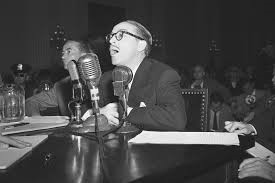
Background
After World War II the United States and the Soviet Union found themselves on opposite sides of a “Cold War,” which pitted the democratic United States against the Communist Soviet Union. As the Cold War intensified, the frenzy over the perceived threat posed by Communists in the U.S. became known as the Red Scare.
HUAC was created in 1938 to investigate alleged disloyalty and rebel activities on the part of private citizens, public employees and organizations suspected of having Communist ties. Citizens suspected of having ties to the communist party would be tried in a court of law. Also during this time, Senator Joseph McCarthy began a campaign against alleged communists in the U.S. government and other institutions. From 1950-1954 “McCarthyism” described the practice of accusing Federal Government employees of having affiliations with communism and leaking information. Government employees could be blacklisted (viewed as untrustworthy or someone to avoid) and could lose their jobs. The threat of Communism was a driving force that created a wedge between society and the United States government.
During this time period the lines of civil liberties and national security began to blur, and U.S. citizens felt a sense of uncertainty. Some Americans felt that their personal freedoms were being taken away, while others believed HUAC and McCarthyism were necessary to secure national security. Government officials felt the same types of pressures on the home front. Were they overstepping government powers or just keeping America safe from outsiders that wanted to cause harm within the system?
Key Question
What is more important — national security or personal freedom?
Directions
Materials
Documents to be examined:
- The President’s News Conference, plus political cartoon, June 16, 1949
- J. Parnell Thomas to Harry S. Truman, September 29, 1948
- Political cartoon, “It’s okay—We’re hunting Communists,” October 31, 1947
- Executive Order 9835
- Letter from Jack Moffitt to Norris Paulson, April 11, 1947
- Letter from “An American” to the Chair of HUAC regarding Gale Sondergaard, March 1951
- Correspondence between J. Parnell Thomas and Harry S. Truman, April 25, 1947
- Harry Truman’s Address at the Dedication of the New Washington Headquarters of the American Legion, August 14, 1951
- Gallup Vault Poll: Celebrity Witnesses before Congress in 1947 Public Opinion, November 1947
- Video, Walt Disney testifies against Communism, 1947
- Video, Pete Seeger testimony on being blacklisted in America, 1965